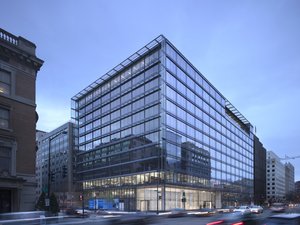The Washington Post is known for a lot of things: Its Pulitzer Prize-winning reporting, its financial comeback after Amazon CEO Jeff Bezos bought the company, and its continued outreach and programming in the local D.C. area.
In D.C., you can add one more item to that list: Having one of the most inclusive engineering teams in D.C. tech.
Looking at the engineering and tech teams at the national brand is impressive: It's filled with women, and not many tech teams can boast that.
DC Inno wanted to know what was behind WaPo's success and also a bit about what the day-to-day environment. Below is an interview with a rotating group of people from The Post's team conducted via email about just that—
DC Inno: Generally, what does The Washington Post engineering team do?
Jen Kastning, manager on the enterprise application development team: The Washington Post’s engineering team builds tools to support not only the needs of The Post’s newsroom, but those of modern digital media companies (ARC platform). We’re helping reinvent the business model on how to sustain news media companies. We experiment and devise new products and solutions based on both our previous experience and where we see gaps in the marketplace.
Who makes up the team? What is the gender ratio?
Kastning: Our engineering department is made up of a diverse group of people covering all aspects of web technology. We have front end and backend engineers, data scientists, network engineers, architects, among others. We also have a range of skillsets, from entry level on up to PhDs.
Over the past couple years, our company has hired more women engineers, bringing in more diversity. You don’t need to do the math; this is evident by walking around the department floor, by looking into meeting rooms (our meeting rooms have glass walls), by seeing diversity in our lunchroom area; wherever you go, there’s always a healthy mix of women and men engineers.
Briefly, how has the engineering team change since The Washington Post was purchased by Jeff Bezos and The Post shifted towards a media and technology focus?
Kastning: Over the past few years, I’ve seen our department shift from a “manage the vendor” culture to a “build and own it ourselves” culture.
We have moved from a very business/process-driven/waterfall approach to a very agile, fast moving, iterative and more ambiguous approach. Previously, projects and requirements would come from the business in a top-down model. Now, our engineers partner with, and in many cases lead projects to help move the business forward. Our engineers help drive requirements, implementing ideas that we think will help position the company for success. We “own” our products just as much as our business does. Long-gone is the term “IT”, instead happily replaced with “Engineering”.
We don’t always start products with a business strategy in mind. Instead, our experimentation leads us to develop products and from there, comes the strategy and then business model. Our ARC platform is a great example of this.
From the tech team themselves
When looking for a job, did you have any considerations specific to being a woman or a woman in tech? What made the Washington Post engineering team an appealing place to work?
Katie Parker, deputy design director for digital: I’ve been fortunate enough to always work in companies where women were respected. At The Post, I’ve always felt valued for my talent and experience. I can’t imagine wanting to stay in a job where I felt disrespected because of my gender.
Kastning: I’ve worked at The Post for many years (back when our department was called IT). Although I did not have a Computer Science degree, The Post recognized my abilities and gave me the opportunity to work in Engineering. I didn’t have specific considerations to being a woman in tech. I was confident in my skillset and The Post recognized that. This is still true today. Our engineering team continuously looks for smart people that will own and drive their tasks, generate new ideas and run with those ideas.
What we do day-to-day makes a difference in many people’s lives. It’s highly-rewarding to share the results of our work every day with our readers. Our environment is exciting and fast-paced. Every day is different. Our culture is very creative, collaborative and forward-thinking, making The Post a very enjoyable place to work.
Hey, @GA_DC. You're the future of technology and we LOVED hosting you today. The future is bright! #dctech pic.twitter.com/gyIoP5EDn0
— Washington Post Life (@WashPostLife) April 19, 2017
Jessica Bell, developer and digital commercial products: Yes, I had been in positions before with no women on the engineering team and few on the leadership team and that wasn’t a fabulous fit—I came to The Post through direct recommendations from my Women Who Code group. Having multiple women in that group give me a realistic picture of what it’s like to be a woman on the engineering team was super helpful. I won’t lie—it was very compelling that there was a big group of technical women that I already knew and trusted giving me good recommendations.
Radha De, developer on enterprise systems DE: This was a major concern for me, because my previous work experience taught me the importance of company culture resonating with my own values, which include working in a diverse environment.
I joined The Post about a year ago, and two major things impressed me while I was interviewing: 1. HR emphasized that there was a big initiative to build on the existing diversity within Engineering, and 2. The team seemed very collaborative and open to my ideas. My technical interview was unlike any others I have done; we white boarded a problem, but it felt like a team meeting, where my interviewers and I all contributed ideas and discussed the pros and cons of each before settling on a final approach.
What makes The Washington Post engineering team successful? How is it different from similar teams in other companies?
Parker: We are scrappy! When I joined The Washington Post in 2010, we were seen as an underdog, at least in the digital realm. I think that’s been a good thing for us. We’ve grown into a digital powerhouse because we’re used to doing a lot with a little. We multi-task really well. We find clever solutions to difficult problems. Managers aren’t afraid to roll up their sleeves and do work. Now that we have more resources, our work ethic and nimble structure have helped us accomplish more than other, larger media companies.
Kastning: Autonomy. Every team within the Engineering department chooses the technology that’s right for them and their job. We use our own tools, develop our own architecture, choose our own languages and develop our own processes. Our engineering team follows a loose structure. There are no imposed standards in place that dictate we “must” use X or Y technology stack. This gives us the flexibility to be fast moving and experiment.
Bell: So far I have not come across any ‘rock star’ developer egos, which for me is a huge red flag. People have been so willing to help each other out. The Post has a large offering of internal and external development projects, which means things can get complicated—but when people are so willing to help you navigate through, it creates an environment where questions are welcomed.
De: I’m still relatively new to the industry, but I like that we are given lots of opportunities to grow our skills and highly encouraged to come up with new ideas and take ownership of them. My manager actively facilitates my learning: just yesterday, he sent me links to YouTube tutorials about machine learning because he knows that developing those skills are one of my goals for this year.
Do you think your ability to successful attract women to the tech team has more to do with the company's overarching policies or the qualities of a specific team? What’s been your experience?
Parker: For a team to really be effective, you need every person to contribute to the best of their abilities. For women to work to their potential, a company needs both progressive policies and teams made up of people who respect women. I don’t think you can have success with just one or the other.
Kastning: Attracting women starts with our hiring managers, making sure they have an open mindset and aren’t “fixed” either consciously or unconsciously set on finding the same cookie-cutter, stereotypical engineer. Our hiring managers, working with our internal engineering recruiter, embrace an open mindset, seeking and sourcing diverse talent.
Additionally, our engineering department has specifically focused on increasing diversity over the past year and a half.
Bell: I think both—if the top priorities of a company don’t support women, then no good team will retain their female engineers long term. Conversely, if the company supports women, but teams treat their female developers poorly, you are going to have the same outcome. Making it clear that the company supports diversity of thought and inclusion of all identities to me is really powerful.
Rather than focusing on, we need X number of Y identity, fostering a team that is used to proactive inclusion, welcomes being questioned and tweaking practices creates an environment where IF you are the one of your kind—you are empowered to speak up and respected by your colleagues.
De: Both aspects matter. I think it’s certainly important for upper level management to be supportive of not only increasing the number of women on the team but also supporting the women who are already there and making sure that every level of the company has diverse representation, from developers to managers and on up the ladder. The company’s overarching policies certainly set the tone for that. But it’s also up to teams and individuals to create an inclusive workplace, where everyone feels welcome and important. I love that I felt valuable from day one, and I think that has spurred me to become a more active, productive member of my team.
How do we to get more girls and women interested in working in tech?
Parker: In general: Keep encouraging young girls and celebrating their curiosity. Help them find role models who are pioneers in their fields. Destroy gender stereotypes. In the workplace: Support other women working in tech. Be visible.
Kastning: By encouraging them at a young age that there are many kinds opportunities for them in engineering and technology fields and to get them interested, excited and passionate about technology. It’s important to showcase all the successful women in our field by sharing their stories of how they got to where they are. Doing this will demonstrate to girls and women that, yes, anything is possible if you work hard.
To help this effort, The Post has started outreach programs working with a few local area high-schools, where a small diverse group of our engineers meet with students interested in engineering fields. The goal of this program is to shed light on the kinds of opportunities and positions that are available, specifically in the web development field, and to share stories of what it’s like to work in engineering. Our engineers share their stories of how they got to be where they are today, many highlighting that that it’s not always required to take the traditional computer science path to work in our field, and that it’s never too late to start a career in engineering.
Bell: Make tech more accessible—which we are starting to see. Starting to address basic tech literacy (what is the difference between front and back end development? How does data move around the internet) can do a lot. Putting technical women into leadership positions—we HAVE women in tech right now—give them visibility, give them good projects, listen to them when you are hiring, makes a big difference.
De: I think early exposure is paramount. I wish I had gotten more opportunities to learn to code when I was younger, because that lack of exposure caused me to fall behind in my engineering classes and subsequently change majors. Now that I am back in the technology sector, I am actively engaged in my community, through The Washington Post as well as other organizations that I volunteer with, to mentor others who are looking to transition careers like I did and to serve as a role model to girls who are interested in STEM.
Images courtesy of The Washington Post.




